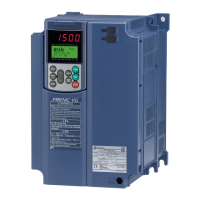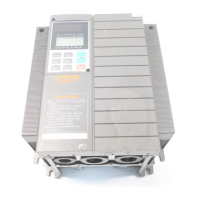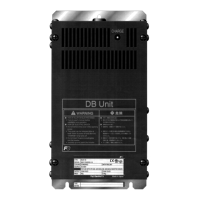5.3 Description of Function Codes
5-97
FUNCTION CODES
Chap 5
F50 to F52
Electronic thermal overload protection for braking resistor
(Discharging capability, Allowable average loss and Braking resistance value)
These function codes specify the electronic thermal overload protection feature for the braking resistor.
Set the discharging capability, allowable average loss and resistance to F50, F51 and F52, respectively. These
values are determined by the inverter and braking resistor models. For the discharging capability, allowable
average loss and resistance, refer to Chapter 11 “11.8.4 Specifications.”
The values listed in the tables are for standard models and 10% ED models of the braking resistors which Fuji
Electric provides. When using a braking resistor of any other manufacturer, confirm the corresponding values with
the manufacturer and set the function codes accordingly.
Set 0.00 to F52 when replacing from FRENIC-Multi.
Depending on the thermal characteristics of the braking resistor, the electronic thermal overload
protection feature may act so that the inverter issues the overheat protection alarm
even if the
actual temperature rise is not large enough. If
this happens, review the relationship between t
he
performance index of the braking resistor and settings of related function codes.
Using the standard models of braking resistor or using the braking unit and braking resistor together can
output temperature detection signal for overheat. Assign
Enable external alarm
trip
) to any of digital input terminals [X1] to [X5], [FWD] and [REV] and connect that terminal and its
common terminal to braking resistor
’s terminals 2 and 1.
Calculating the discharging capability and allowable average loss of the braking resistor and configuring
the function code data
When using any non-Fuji braking resistor, inquire to the resistor manufacturer about the resistor rating and then
configure the related function codes.
The calculation procedures for the discharging capability and allowable average loss of the braking resistor differ
depending on the application of the braking load as shown below.
<Applying braking load during deceleration>
In usual deceleration, the braking load decreases as the speed slows down. In the deceleration with constant
torque, the braking load decreases in proportion to the speed.
Use Expressions (1) and (3) given below.
Applying braking load during running at a constant speed
Different from during deceleration, in applications where the braking load is externally applied during running at a
constant speed, the braking load is constant.
Use Expressions (2) and (4) given below.
<Applying braking load during deceleration> <Applying braking load during running at a constant speed>

